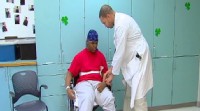http://abcnews.go.com/Health/electrical-stimulation-speed-learning-stroke-recovery/story?id=14570429

A mild zap to the brain could help people learn faster, according to new research recently presented at the British Science Festival.
The same technique might also someday help stroke patients recover lost motor skills.
Researchers at the University of Oxford have found that applying a small amount of electric current to the brain sped up learning, said the British Science Association, which sponsored the festival.
Using a technique called transcranial direct current stimulation (tDCS), a team of scientists, led by Heidi Johansen-Berg, electrically stimulated the brains of subjects trying to learn a computer game that required a series of button presses. The current was applied to the part of the brain that controls movement for about 10 minutes either before or during the game.
Subjects who received the current learned the sequences faster than subjects who received only a quick burst of electricity before the game.
"While the stimulation didn't improve the participant's best performance, the speed at which they reached their best was significantly increased," Johansen-Berg told BBC News.
The stimulation, Johansen-Berg added, could help people recovering from strokes. In a separate experiment, stroke patients who received the same electrical stim ulation showed improved motor function.
ulation showed improved motor function.
Go to the URL to see these 3 videos.
Technique Promising for Stroke Recovery
Dr. Sarah Lisanby, chairwoman of the Department of Psychiatry and Behavioral Sciences at Duke University in Durham, N.C., has been involved in her own research using tDCS. She said the current acts on the parts of the brain affected by a stroke.
"By using direct current application during the performance of a task that engages the circuits affected by a stroke, the current can help facilitate the response that leads to recovery," she said. The technique, she said, shifts the electrical potential of the brain to facilitate learning.
Experts say it makes sense that a technique such as tDCS that might affect learning could also help stroke patients improve their level of functioning.
"Stroke recovery is a form of learning, but the brain cells involved in learning are damaged," said Dr. David Alexander, professor of neurology and medical director of the UCLA Neurological Rehabilitation and Research Unit. "We want brain cells uninvolved in the stroke to take over function, but those cells will have to learn that function that's been lost."
Lisanby said there have been a number of studies looking at tDCS and its potential for treatment of a variety of other conditions, such as depression and schizophrenia, as well as examining the effects of tDCS on memory and other kinds of learning.
A recent study, also done by researchers at the University of Oxford, found that tDCS improved math performance for up to six months.
Despite the positive findings, experts say, there's still a way to go until tDCS is used in a clinical setting. "We need to understand what happens at a cellular level and fine tune that," Alexander said.
Lisanby said the technique does have several advantages -- it's safe, portable and inexpensive -- but larger studies and a better evaluation of safety are needed before being able to use tDCS as treatment.
"The impact of this work goes beyond stroke to illustrating how targeted neuromodulation can unlock the mysteries of the brain's potential for resilience and how that may ultimately be applied to clinical treatment of brain-based disorders," Duke University's Lisanby said.



No comments:
Post a Comment